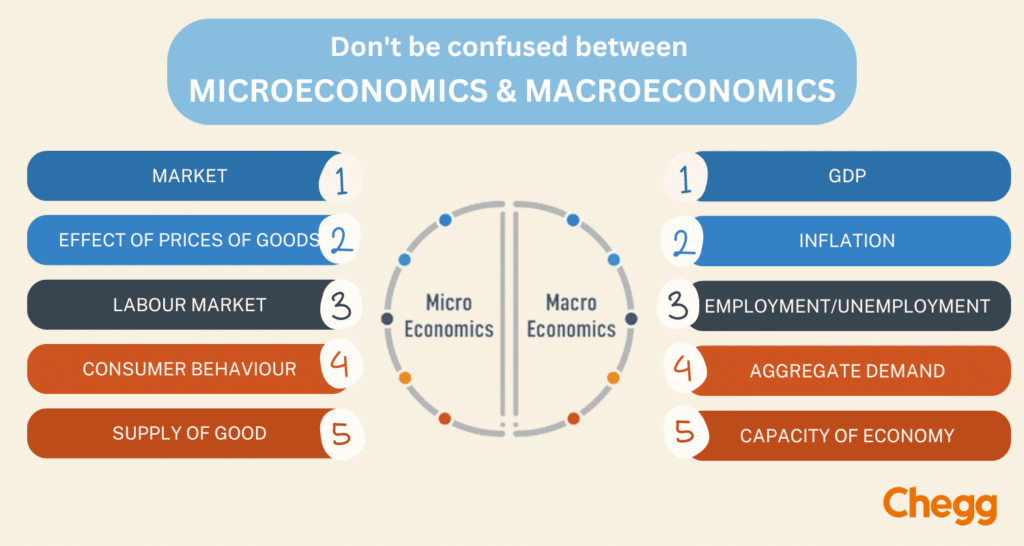Home » Career Guidance » Exploring the Contrasts Between Microeconomics and Macroeconomics
Exploring the Contrasts Between Microeconomics and Macroeconomics

Table of Contents
Economics is a branch of knowledge that studies the financial structure of a nation and the factors influencing it. It is the social science that deals with the production, consumption, and distribution of goods and services. The subject of economics comprises two branches – Microeconomics and Macroeconomics. These are the two main categories of economics.
While Microeconomics studies the individual units of a country’s economy, Macroeconomics deals with the entire economy of a country as a whole. These two branches of economics explain how economies work; ranging from the economy of just an individual to the economy of an entire country.
This article will focus on understanding the two concepts – Microeconomics and Macroeconomics, and the major differences between Microeconomics and Macroeconomics.
Difference between Microeconomics and Macroeconomics
| Basis | Microeconomics | Macroeconomics |
| Meaning | Microeconomics is the study of individual units of the economy of a nation. | Macroeconomics studies the aggregate variables of the economy of a nation. |
| Area of Study | The area of study of Microeconomics includes the particular market segment of an economy. | The aggregate or total market segments of an economy are included in the Macroeconomics’ area of study. |
| Deals with | Microeconomics deals with multiple issues such as: Demand and Supply, Product pricing, Factor pricing, Production, Consumption, Economic welfare | Macroeconomics deals with several issues such as: National Income, Employment Distribution, General price level. |
| Area of Application | Applied to internal issues. | Applied to external and environmental issues. |
| Concept | Narrow | Wide |
| Scope | Theory of product pricing, Theory of factor pricing, Theory of economic welfare | Theory of economic growth and development, Theory of money, Theory of national income, Theory of international trade, Theory of employment, Theory of general price level |
| Importance | Helps in the determination of prices of products or commodities, along with the pricing of factors of production in an economy. | Helps in dealing with critical issues like inflation, deflation, reflation, unemployment, and poverty in an economy as a whole. |
| Limitations | The study is based on presuppositions. | The study incorporates the misconception of composition. |
Before heading towards the difference between Microeconomics and Macroeconomics, let us first understand each branch of economics separately.
What is Microeconomics?
Microeconomics is the study of the Microelements of the economy. These Microelements can be a single individual, a household, or a business firm. The way these elements maintain their economy, that is, allocate their scarce resources and their interaction with other elements is studied under Microeconomics.
Microeconomics generally analyses the market and determines the prices of goods and services. It studies how individuals or firms allocate their resources, and how it affects the utilisation and distribution of their resources.
Principles of Microeconomics
Microeconomics comprises the following principles:
- Demand and supply equilibrium
- Utility maximisation
- Production theory
- Opportunity cost
- Cost of production
What is Macroeconomics?
Macroeconomics is a study of the macro elements in economics. It is the aggregate study of the economy of a nation. Macroeconomics deals with the performance, structure, behaviour, and decision-making of the entire economy as a whole.
It analyses the markets, businesses, industries, and governments on an overall basis. The government policies and the factors influencing the economy of a nation are covered under the scope of Macroeconomics.
Principles of Macroeconomics
Macroeconomics comprises the following principles:
- Economic growth
- Economic output
- Unemployment
- Inflation & Deflation
- Investment

Relation Between Microeconomics and Macroeconomics
Microeconomics and Macroeconomics are two distinct branches of economics. While Microeconomics focuses on the economic behaviour of individuals and firms in the market, Macroeconomics focuses on the overall performance of the economy as a whole. The two branches of economics are closely related and interact with each other.
In Microeconomics, the behaviour of individual consumers and firms is studied to determine how they interact in the market to produce and allocate resources. This economic behaviour is then used to analyse the overall performance of the economy. For example, the demand and supply of a certain good can be studied to understand how it affects the overall price level.

On the other hand, Macroeconomics focuses on the aggregate economic performance of a nation. It examines the factors that affect the overall economic performance such as GDP, inflation, unemployment, and trade balance. It also studies the effect of fiscal and monetary policies on the economy.
The two branches of economics interact with each other. Microeconomic decisions of households and firms affect the Macroeconomic performance of the economy. For example, the decisions of households to consume or save can affect the overall level of economic growth. Similarly, the decisions of firms to invest or not can affect the overall level of investment in an economy.
Significance of Microeconomics Vs Macroeconomics
Both Microeconomics and Macroeconomics hold importance in their own area of application.
Importance of Microeconomics:
There is both practical and theoretical importance of Microeconomics. The primary significance is that it helps in determining the prices of commodities in an economy. Microeconomics plays a vital role in formulating policies that help in enhancing production efficiency and result in greater economic welfare. It allows to determine the working of a capitalist economy and the equilibrium price of a free economy.
Importance of Macroeconomics:
As Macroeconomics studies the entire economy of a country as a whole, it helps in understanding the functioning of a complex modern economic system. It allows determining the level of national income and employment with the help of aggregate demand and supply. Macroeconomics analyses the fluctuations in business activities and helps in maintaining a stable price level.
Microeconomics vs Macroeconomics – Scope
Let us now understand the scope of Microeconomics and Macroeconomics.
Scope of Microeconomics:
The scope of Microeconomics mainly consists of three theories –
- Theory of product pricing
- Theory of factor pricing
- Theory of economic welfare
Scope of Macroeconomics:
The scope of Macroeconomics includes the following theories –
- Theory of economic growth and development
- Theory of money
- Theory of national income
- Theory of international trade
- Theory of employment
- Theory of general price level
Microeconomics and Macroeconomics – Limitations
The differences between Micro and Macroeconomics can also be understood based on the constraints faced by it. Here are the limitations of Microeconomics and Macroeconomics:
Limitations of Microeconomics:
- It incorporates unrealistic assumptions. Conditions such as full employment and perfect competition are assumed which are not feasible.
- The approach proves to be misleading in certain cases. Applications for individuals may not apply to economies.
- The scope of Microeconomics is quite narrow and limited.
- The concept of Microeconomics is too generalised.
Limitations of Macroeconomics:
- The misconception of composition is incorporated in the study of Macroeconomics. Theories that are true for aggregates may not be the same in the case of individuals.
- Measuring the aggregate variables is a difficult task due to the presence of numerous items in groups.
- Macroeconomics deals with the aggregate study of the nation’s economy. As a result, comprehensive groups are given more importance, thereby lacking individual units.
Micro vs Macro Economics
Economics is indeed a professing career option as the knowledge imparted in this study contributes greatly to a nation’s both Microeconomics and Macroeconomic model. Microeconomics focuses on individual markets, while Macroeconomics focuses on whole economies. The main difference between Microeconomics and Macroeconomics is the scale.
Microeconomics studies the behaviour of individual households and firms in making decisions on the allocation of limited resources. Another way to phrase this is to say that Microeconomics studies markets.
On the other hand, Macroeconomics is generally focused on countrywide or global economics. Its studies involve total economic activity, dealing with growth, inflation, and unemployment. In this article, we have discussed the key difference between Microeconomics and Macroeconomics. The primary comparison between Micro vs Macro has been made above which can help you get a clear understanding of both branches of economics. As you read the subjects in greater depth, there will be a lot more to analyse.
Frequently Asked Questions
Microeconomics studies topics such as supply and demand, cost and production, pricing, market structures, and consumer behaviour.
Macroeconomics looks at national and international economic trends such as unemployment, inflation, economic growth, and monetary and fiscal policy.
Some Useful Resources
To read more related articles, click here.
Got a question on this topic?